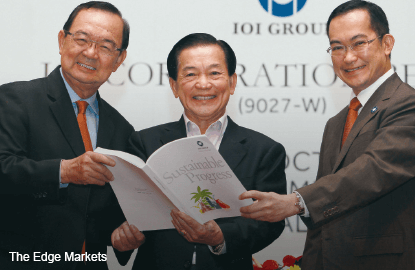
This article first appeared in The Edge Financial Daily, on October 28, 2015.

PUTRAJAYA: IOI Corp Bhd sees the effects of the dry El Niño conditions and haze cutting its production of oil palm fresh fruit bunch (FFB) by 10% from its normal level, but giving the much-needed support to crude palm oil (CPO) prices.
“I do not see [lower crop production] having a negative impact on our profitability [for the financial year ending June 30, 2016 (FY16)]. There is a good chance [CPO prices] will go up [offsetting the 10% drop in FFB production],” IOI Corp chief executive officer Datuk Lee Yeow Chor told reporters after the company’s annual and extraordinary general meetings yesterday.
Lee expects CPO prices to stabilise at current levels until the end of the year and start to pick up in the first quarter of next year. Lee, however, did not give a price target range.
For FY16, IOI Corp has lowered its FFB production growth forecast to 3%-5% from 5%-7% previously.
On its earnings for FY16, Lee said the outlook for the group remained positive, aided by its downstream activities which have exceeded expectations.
“Our oleochemical segment has performed well in the last five to six months due to low palm kernel oil prices,” he said.
“I am not sure how our [1QFY16 and FY16] results will be, but as I had mentioned earlier, we expect CPO prices to go up and this is good for the group,” Lee added.
The benchmark January contract closed up 36 points at RM2,315 per tonne yesterday, from RM2,279 per tonne on Monday.
IOI Corp is due to release its first-quarter results for the three months ended Sept 30, 2015 (1QFY16) on Nov 15.
In a report last month, Maybank Investment Bank Research estimated that IOI Corp may sink into the red in 1QFY16, with a possible net loss of RM440 million due to an estimated RM670 million unrealised foreign exchange translation losses on its US dollar debt-related exposure of RM6.25 billion. The ringgit declined 16.5% to 4.395 against the US dollar during the third quarter of 2015.
For FY15, the group saw its net profit plunge 95% to RM168.1 million from RM3.37 billion the previous year due to a net foreign currency translation loss on foreign currency-denominated borrowings of RM735.3 million. Revenue for FY15 came in 2.43% lower at RM11.62 billion against RM11.91 billion in FY14.
Lee also sees minimal impact from the increase in minimum wage come July 1, 2016, saying all of IOI Corp’s workers are already earning above the levels.
From July 1, 2016, the national minimum wage will be increased from RM900 to RM1,000 per month for workers in Peninsular Malaysia and from RM800 to RM920 for those in Sabah, Sarawak and Labuan.
Lee said even after stripping off the allowances and incentives, only some 15% to 20% of its total plantation work force of 25,000 are now earning the prevailing federal minimum wage.
Using back-of-the-envelope calculations, assuming the increment is RM100 per worker, IOI Corp may have to fork out an additional RM4.5 million to RM6 million for its workers’ remuneration a year.
Meanwhile, the weakening ringgit does not bode well for IOI Corp, putting further pressure on its translation loss as some 90% of its debt is denominated in US dollars.
Its total net debt stood at RM4.7 billion, while its gross debt was RM6 billion as at June 30, 2015.
Lee, however, said its debt level will not affect the group’s cash for now, as 50% of the debt will only mature beyond 2022.
“We can only see the exact impact in FY17 as the repayment will come in during that financial year,” he said.
The weaker ringgit will also put pressure on its cost structure, Lee said, adding that every 20% rise in the US dollar against the ringgit will translate into a 3% rise in fertiliser cost. The fertiliser cost makes up 15% to 20% of the total cost of the group.
“Currently, our cost of production stands at RM1,400 per tonne and the fertiliser cost for the next three months has been locked in,” he pointed out.